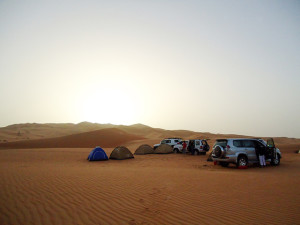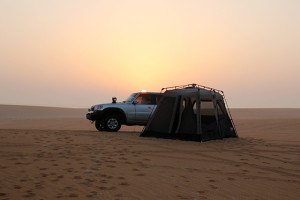Words + Photos By: Marina Bruce
For centuries the bedu have travelled through the Western Region by camel, stopping at nightfall to rest, so what better way to experience the magic of the Empty Quarter than to camp? The UAE still embraces its bedu traditions and aside from restricted areas, which are normally marked by fences and signs, as well as cultivated areas, you can camp more or less anywhere.
My favourite type of camping when off-roading is expedition camping – stop about 30 minutes before nightfall each day of the trip and set up camp. If you set up a “basecamp,” which you come back to each night, although you can increase the level of luxury in your camp, you always have the problem of having to return to that spot at the end of your drive. Sometimes you have a breakdown or simply “run out” of daylight and then you have to struggle through the darkness to find your bed!
For single night camps, I normally just take the just the basics – the more kit you have with you the longer it will take to stow it all away securely in the morning, possibly delaying your convoy’s departure.
As a guide, it takes an experienced group of campers around 1.5 hours from wake up to move off, allowing time to cook/eat breakfast. If you’re not a morning person then set your alarm for two hours before to give you a more relaxed start to the day!
For most of the camping season a light dew falls on the dunes around two hours before sunrise which makes the sand firmer and the driving easier early in the morning.
Camping season
The camping experience varies from season to season generally.
1st Dec – 28th Feb: Can become very cold at night and 30% of the time you can expect early morning fog which typically curtains the area in cloud from 5:30am through to 9:00am.
1st Mar – 30th April: Days become warmer and the nights start heating up too. Less chance of fog. Sun rises earlier and by April you are hounded out of your tent by the heat of the sun!
1st May – 30th Sep: Very hot during the day and also at night too – it’s safe to say that only “hardcore” campers venture out with their tent at this time of year.
1st Oct – 30th Nov: In October, the days are hot and the nights bearable, but like in April, you still have to beat a retreat out of your tent shortly after dawn or you will cook. Throughout the autumn months the days become progressively cooler yet the mercury rarely goes below a comfortable 15°C overnight.
Apart from foggy mornings, it’s unusual for the area to have high humidity at any time of year, meaning even high temperatures are tolerable.
The magic temperature for many families is 25°C – when this is the forecasted minimum temperature overnight then it should be reasonably comfortable to camp.
Choosing your campsite
Choose your campspot according to the season. In spring and autumn you will find it coolest to camp in an elevated position as this will allow you to benefit from any cooling breeze but make sure your tent is adequately secured as there can be some moderate gusts of wind around sunset.
In winter, the best camp spots are those which offer shelter from the prevailing wind. Try to find a flat bottomed bowl but do make sure you mark the top of the dune with a flag or flagpole or a glow stick, so any quad bikers will know you are there and not end up parked on top of your tent!
Try to keep away from farms whether temporary or permanent – these are the livelihood of many locals, and always remember to take all your garbage out of the desert with you. You will have more privacy if you are one or two dune lines away from them and it’s always a good idea to camp upwind from a camel farm!
Equipment
You can choose from a huge selection of specialist suppliers, supermarkets and local camping shops. If you are in a different environment from your homeland be aware that the features you require here may be different to your home country.
If you dislike insects, then buy a tent with a sewn in groundsheet and a flysheet which stops well short of the ground, thus removing possible shelter for spiders, scorpions and the like. If you do have a flysheet on your tent, don’t leave boots outside the sleeping compartment as creatures looking for a warm place to snooze might crawl in during the night. Always shake your boots out before putting them on if you do.
Camping at the beginning and end of the “season” is best enjoyed in a tent with lots of mesh windows to allow a good flow of cooling air, yet in the coldest months a small tent is much warmer!
Choose a tent that is simple and easy to erect and dismantle – you will be glad of this on a windy afternoon!
Safety
Protect your tent from burning embers by pitching it a reasonable distance from your campfire.
When packing away your tent, dismantle the poles, remove the pegs, and then drag it to an area clear of plants, a few metres from where it was pitched. This reduces the chances of you kneeling on a scorpion, who have been known to sleep under tents.
Tent pegs
There are three types of tent pegs – the cheap ones normally supplied with your tent, sand pegs and rock pegs. Sand pegs are made of a long v-shaped piece of metal and when driven in to the sand at an angle, should secure your tent well. Rock pegs look like 12in nails with a hook attached to the top and can be driven into very hard surfaces, including wet sand. The conventional pegs which come with your tent are sometimes of little use in sandy or rocky conditions.
Bedding
Your options for sleeping will be dictated by the space in your tent and also in your car.
One of the most comfortable options are foam Z-mattresses available cheaply from supermarkets, although these are very bulky.
Airbeds are very popular and can be pumped up using a hand pump or an electrical one which works from the 12v socket in your car. Make sure the inlet/outlet are kept clear of sand as even the tiniest particles spoil the seal and can cause your bed to deflate during the night.
Thin camping mats will give you some protection from the ground and are ideal if you are pushed for space in your car or are travelling by motorbike.
Make sure you keep your bed and bedding at least 20cms from the edge of your tent so that they don’t absorb condensation from the sides.
Sleeping bags in various weights can be bought throughout the Emirates but the drawback with these is that they lack flexibility. In the spring and autumn they maybe too hot and in the winter you would need to take extra blankets.
Blankets are readily available to buy here in a variety of weights, all at a relatively low cost. Work out how many you think you will need and take an extra two – if it is cold you can place one below you and this will make your bed warmer.
Campfire tips
Firewood is available to buy from many shops, often in tourist or industrial areas throughout the Emirates. If you see some at a shop on your way to Liwa it’s sometimes an idea to buy it there as in the remote areas of Al Gharbia there are fewer shops.
Please have respect for the environment – do not chop down or uproot existing trees or bushes, and always clean up your campfire before you leave camp. Bottles and tin cans will not burn so take them away with the rest of your garbage.
Chances are you will be in a very remote area for your camp, many kilometres distant from medical help. Take the utmost care with your campfire and do not let anyone walk near it with bare feet.
Burn some frankincense on the fire to release its lovely perfume and keep insects away.
Remove the top of drinks cans with a tin opener. Fill ¾ full with sand, use as a tealight candle holder.




